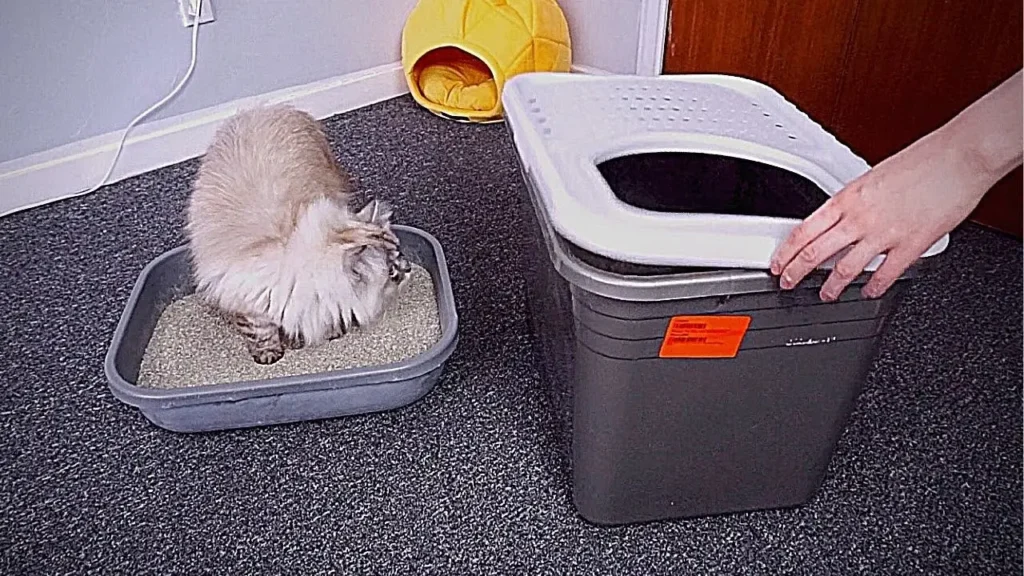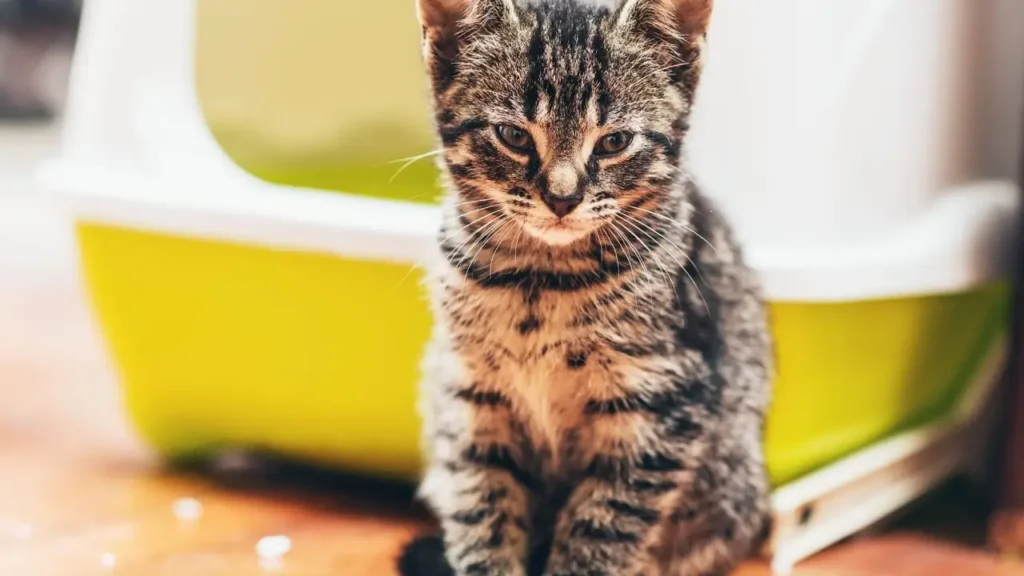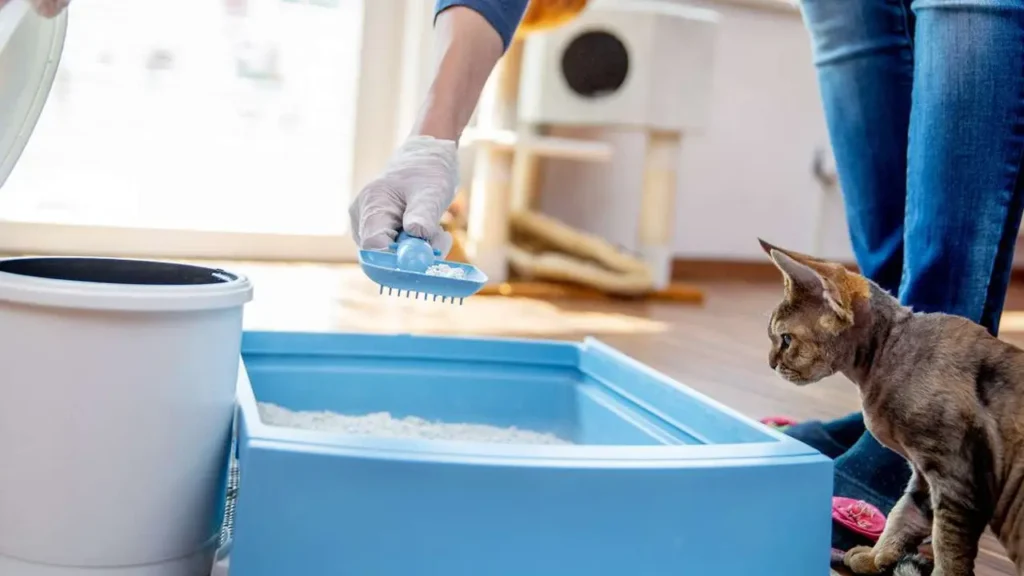Introducing a new litter box to your cat can sometimes be a challenge. Cats can be creatures of habit, and they may resist change. However, with a little patience and understanding, you can successfully transition your cat to a new litter box.
In this blog post, we’ll discuss:
- Understanding your cat’s preferences: Identifying your cat’s needs and preferences when it comes to litter boxes.
- Gradual introduction: Tips for introducing the new litter box slowly and gently.
- Creating a positive association: Ways to make the new litter box more appealing to your cat.
- Addressing potential issues: Troubleshooting common problems that may arise during the transition.
By following these guidelines, you can help your cat adjust to the new litter box and avoid any unwanted behaviors.
Why Switching to a New Style of Litter Box

Switching to a new style of litter box can be beneficial for several reasons:
- Improved Hygiene: Some litter box styles, such as hooded or enclosed boxes, can help to contain litter and reduce tracking throughout your home. This can lead to a cleaner and more hygienic environment.
- Increased Privacy: Cats often prefer privacy when using the litter box. Hooded or enclosed boxes can provide a more private and comfortable space for your cat to relieve themselves.
- Reduced Stress: Some cats may feel anxious or stressed when using open-top litter boxes. Switching to a covered or enclosed box can help to reduce their anxiety and make them more comfortable using the litter box.
- Odor Control: Certain litter box styles, such as hooded boxes with built-in ventilation, can help to control odors and keep your home smelling fresh.
- Customization: There are a variety of litter box styles available, allowing you to choose the one that best suits your cat’s needs and preferences.
If you’re considering switching to a new style of litter box, it’s important to choose one that is appropriate for your cat’s size, breed, and personality. You may also want to consider factors such as your home’s layout and your personal preferences.
By carefully selecting a new litter box style, you can help to create a more comfortable and hygienic environment for your cat.
How to Attract Cat to New Litter Box?

Introducing a new litter box to your cat can sometimes be a challenge. Here are some tips to help your cat adjust:
Understanding Your Cat’s Preferences
- Location: Choose a quiet, private location away from food and water sources.
- Number of litter boxes: If you have multiple cats, provide at least one litter box per cat plus one.
- Litter types: Consider your cat’s preferences when choosing litter. Some cats prefer uncovered boxes, while others may prefer covered ones.
Gradual Introduction
- Place the new litter box near the old one: This will make it easier for your cat to find and get used to the new litter box.
- Mix the litter: Gradually mix the new litter with the old litter over several days.
- Be patient: Allow your cat time to adjust to the new litter box and litter.
Creating a Positive Association
- Cleanliness: Keep the litter box clean and fresh to encourage your cat to use it.
- Positive reinforcement: Reward your cat with treats or praise when they use the new litter box.
- Avoid punishment: Never punish your cat for using the wrong spot. This can create anxiety and make the transition more difficult.
Addressing Potential Issues
- Litter box aversion: If your cat seems to be avoiding the new litter box, try moving it to a different location or using a different type of litter.
- Medical issues: If your cat is suddenly avoiding the litter box, it could be due to a medical issue. Consult with your veterinarian to rule out any health problems.
By following these tips, you can help your cat adjust to a new litter box and avoid any unwanted behaviors.
Precious Cat Cat Attract Problem Cat Training Litter
Is your cat having trouble using the litter box?
This common problem can be frustrating for both you and your feline friend. Here are some tips to help attract your cat to the litter box and resolve any issues:
Understanding the Problem
- Medical Issues: Check for underlying health problems that might be affecting your cat’s behavior.
- Litter Box Placement: Ensure the litter box is in a quiet, private location away from food and water.
- Litter Type: Experiment with different litter types to find one your cat prefers.
- Litter Box Number: If you have multiple cats, provide at least one litter box per cat plus one.
Training Techniques
- Positive Reinforcement: Reward your cat with treats or praise when they use the litter box correctly.
- Gradual Introduction: If introducing a new litter box, do so gradually by placing it near the old one.
- Cleanliness: Keep the litter box clean and fresh to encourage your cat to use it.
- Rule Out Medical Issues: Consult a veterinarian to rule out any underlying health problems that might be causing the issue.
Additional Tips
- Consider a Covered Litter Box: Some cats prefer privacy and may be more likely to use a covered litter box.
- Try a Different Litter: Experiment with different types of litter to find one your cat prefers.
- Consult a Veterinarian: If you’ve tried everything and your cat is still having trouble using the litter box, consult with a veterinarian for further advice.
Remember, patience and consistency are key when training your cat. With a little effort, you can help your feline friend learn to use the litter box properly.
8 Tricks to Introduce Your Cat to a New Litter Box

1. Control Variables for the New Litter Box
- Location: Choose a quiet, private area away from food and water sources. Cats generally prefer a calm environment for their litter box. Avoid placing the box near noisy areas or areas with high foot traffic.
- Size: Ensure the new litter box is large enough for your cat to comfortably move around in. A cramped litter box can make your cat feel uncomfortable and may discourage them from using it. As a general rule, the litter box should be at least twice the length of your cat’s body.
- Material: If your cat has a preference for a specific material, such as plastic or ceramic, choose a new litter box that matches their preference. Some cats may be more sensitive to certain materials, so it’s important to consider their comfort level.
2. From Unhooded to Hooded / Enclosed
- Start with an open-top litter box: If your cat is used to an open-top litter box, start with a similar style. This will make the transition less jarring for them.
- Gradually introduce the hood: Once your cat is comfortable using the open-top litter box, you can slowly introduce a hooded or enclosed option. Start by leaving the hood off for a few days and then gradually lower it until it’s fully closed. This will give your cat time to adjust to the new environment.
3. Think Outside the Box, So Your Cat Can Do It Inside
- Experiment with different litter types: Some cats may have preferences for certain types of litter, such as clumping or non-clumping, scented or unscented. Experiment with different options to find what your cat likes best.
- Adjust the litter depth: Try varying the depth of the litter in the box. Some cats may prefer a deeper or shallower litter. A deeper litter can provide more privacy, while a shallower litter may be easier for smaller cats to navigate.
4. Know When It’s Not Your Cat, It’s the Box
- Rule out medical issues: If your cat suddenly starts avoiding the litter box, it could be due to a health problem. Consult with your veterinarian to rule out any underlying medical conditions.
- Check for cleanliness: Ensure the litter box is clean and free of any unpleasant odors. A dirty litter box can discourage your cat from using it.
- Consider the location: If your cat is still avoiding the litter box, try moving it to a different location. Sometimes, a change of scenery can help.
5. Leave the Old Bin for a While
- Gradual transition: Keep the old litter box in place for a few days while introducing the new one. This will allow your cat to get used to the new litter box without feeling overwhelmed. Once your cat is consistently using the new litter box, you can remove the old one.
6. Make the New Litter Box More Attractive Than the Old One
- Cleanliness: A clean litter box is more inviting to cats. Make sure to scoop out soiled litter daily and clean the box regularly.
- Comfort: Place a soft blanket or cushion in the bottom of the litter box to make it more comfortable for your cat.
- Privacy: Ensure the litter box is placed in a quiet, private area away from food and water sources. Cats generally prefer a calm and secluded environment for their litter box.
7. Don’t Put the Hood on the New Litter Box Just Yet
- Start with an open-top box: Allow your cat to get used to the new litter box without the added stress of a closed-in space. Once your cat is comfortable using the open-top box, you can gradually introduce the hood.
8. Be Patient with Your Furry Friend
- Give your cat time to adjust: It may take a few days or weeks for your cat to get used to the new litter box. Be patient and consistent.
- Positive reinforcement: Reward your cat with treats or praise when they use the new litter box. This will help create a positive association with the new litter box.
- Avoid punishment: Never punish your cat for using the wrong spot. This can create anxiety and make the transition more difficult.
By following these tips, you can help your cat successfully transition to a new litter box and avoid any unwanted behaviors.
Conclusion
Attracting your cat to a new litter box can be a challenge, but it’s possible with patience and understanding. By following the tips in this guide, you can create a positive environment and encourage your cat to use the litter box as intended.
If you’re struggling to find the right cat litter for your feline friend, consider customizing your own blend. Our team can help you create a custom cat litter that meets your cat’s specific needs and preferences.
Contact us today to learn more and get a quote for your custom cat litter.









